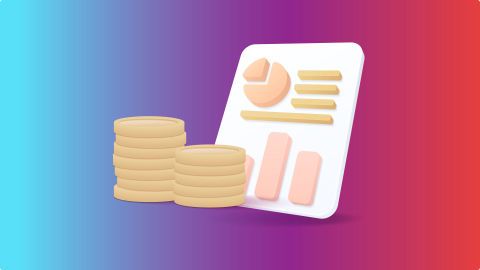If you are a salaried employee in India, you might have noticed a tax deduction on your payslip every month. That deduction is TDS Tax Deducted at Source—mandated by Section 192 of the Income Tax Act. It ensures that taxes are collected right when your salary is paid, whether it’s in advance, delayed, or on time. This system aims to simplify tax compliance and make tax collection more efficient for both employees and the government.
In this article, we’ll break down Section 192 in simple terms, from how TDS on salary is calculated to who deducts it, timelines, exemptions, and what happens if it isn’t done right. Understanding how TDS affects your in-hand salary can help you plan your monthly savings more effectively. If you're looking to grow that savings amount smartly, tax-saving investments like mutual funds can be a good place to start. Save Taxes with ELSS Mutual Funds!
What is section 192 of the Income Tax Act?
Section 192 of the Income Tax Act, 1961, lays down the rules for deducting tax on salaries. It applies to anyone who is responsible for paying salary income—typically your employer. Under this section, the employer must estimate your total taxable salary for the year and deduct tax each month based on the applicable income tax slabs.
The key point? TDS is not deducted when the salary becomes due—it’s deducted only when the salary is actually paid. After deducting the tax, the employer has to deposit it with the government. You, as an employee, receive a Form 16 as proof, which helps you while filing your income tax return. The employer also needs to file quarterly TDS returns in Form 24Q to report these deductions. If you are a salaried employee, understanding your TDS helps you manage your cash flows better—and that extra clarity could also be channelled into building wealth through regular SIPs. Start your SIP tax-saving journey from Rs. 100!
Formula to calculate TDS on salary
Wondering how your employer calculates that monthly TDS deduction? Here's the basic formula:
TDS rate = Income tax payable (as per slab) ÷ Total salary for the year
Let us say your estimated annual income tax liability is Rs. 1,20,000 and your total salary for the year is Rs. 12 lakh. Your TDS rate would be 10%. This rate is then applied each month to ensure that your tax dues are spread evenly throughout the financial year.
This estimated tax can change if your income or exemptions change during the year—say, you invest in ELSS later or get a salary hike.
Who deducts TDS under section 192?
It’s not just companies that are responsible for deducting TDS. Section 192 applies broadly to any person or entity paying out salaries. This includes:
Individuals or sole proprietors
Hindu Undivided Families (HUFs)
Partnership firms
Public and private companies
Central and state governments
Trusts and co-operative societies
Public Sector Undertakings (PSUs)
Whether you work for a private startup or a state-run PSU, your employer is legally bound to deduct TDS on your behalf provided your salary exceeds the basic exemption limit under the Income Tax Act.
When is TDS deducted und er Section 192?
TDS on salary is deducted only at the time of payment, not when the salary becomes due. That means whether you’re paid in advance, after a delay, or right on time—TDS kicks in when the money actually lands in your account.
Employers typically deduct TDS every month and must deposit it with the government within a specified time. However, there's a threshold below which no TDS is required. If your salary doesn’t exceed the basic exemption limit, your employer isn’t obligated to deduct any tax.
Here’s how the exemption limits are structured:
Income up to Rs. 2.5 lakh: No tax
Rs. 2.5 lakh – Rs. 5 lakh: 5%
Rs. 5 lakh – Rs. 7.5 lakh: 10%
Rs. 7.5 lakh – Rs. 10 lakh: 15%
Rs. 10 lakh – Rs. 12.5 lakh: 20%
Rs. 12.5 lakh – Rs. 15 lakh: 25%
Above Rs. 15 lakh: 30%
This is especially important if you're opting for the old tax regime, where deductions and exemptions can further reduce your tax liability.
What is TDS computed on?
Your TDS isn’t calculated on just your basic pay. It’s based on your Cost to Company (CTC), which includes both fixed and variable components.
Fixed pay includes your basic salary and dearness allowance. Variable pay can include:
House Rent Allowance (HRA)
Medical allowance
Travel reimbursement
Performance bonuses
Meal vouchers or food coupons
However, not all of this is fully taxable. You can claim exemptions—like submitting rent receipts for HRA or medical bills for reimbursement—to reduce your taxable income.
So while TDS is deducted on your salary, you have room to reduce that amount by taking advantage of applicable deductions. This is why it’s important to understand your salary structure and submit investment proofs on time. Once you identify what’s taxable and what’s exempt, you can plan smarter by redirecting your savings into investments that also help you reduce your tax liability like ELSS mutual funds. Save Taxes with ELSS Mutual Funds!
How to calculate TDS on salary under Section 192?
Here’s a simplified step-by-step process employers follow to calculate TDS on salary:
Calculate total earnings:
Add up your total expected annual income—basic salary, bonuses, perks, etc.Gather investment declarations:
Employers ask employees to submit proofs for eligible deductions—like life insurance, mutual fund SIPs, tuition fees, etc.Apply exemptions:
Based on those declarations, employers deduct applicable exemptions like HRA, LTA, and standard deduction from the total income.Calculate taxable income:
Subtract deductions and exemptions from gross income to arrive at taxable income.Apply tax slabs:
Tax is then calculated based on the applicable tax slabs under either the old or new regime.Deduct and deposit TDS:
Finally, monthly TDS is calculated by dividing total tax liability by 12 and deducted from salary each month. The employer then deposits it with the government.
Example of Section 192 deduction
Let’s look at a simple case to understand how TDS works when deductions come into play.
Suppose you earn a salary of Rs. 4,00,000 a year and also have other income—say, Rs. 20,000 from a side gig. On the flip side, you’re paying Rs. 2,15,000 in interest on a self-occupied home loan.
Now, your taxable income is calculated like this:
(Rs. 4,00,000 + Rs. 20,000) – Rs. 2,15,000 = Rs. 2,05,000
Since this amount is below the basic exemption limit, your employer won’t deduct any TDS. This shows how deductions and exemptions can bring your tax liability down to zero—even if you have multiple income sources.
Example of TDS calculation on salary
Now let’s take a more typical scenario where TDS is actually applicable.
Imagine your annual estimated salary is Rs. 9,60,000. After subtracting a standard deduction of Rs. 50,000, your gross total income becomes Rs. 9,10,000.
Now let’s assume you invest Rs. 1,50,000 in instruments covered under Section 80C (like PPF or ELSS). This brings your total taxable income down to Rs. 7,60,000.
Here's how the tax liability breaks down:
Tax as per slab: Rs. 64,500
Add 4% Health & Education Cess: Rs. 2,580
Total tax liability: Rs. 67,080
So, your monthly TDS comes to Rs. 5,590 (Rs. 67,080 ÷ 12).
This amount is deducted from your monthly salary, and you take home the rest.
With monthly in-hand figures known, you can confidently start a Systematic Investment Plan (SIP) that aligns with your income, helping you build wealth without straining your cash flow. Start Investing or SIP with Just Rs. 100!
How is TDS deducted in case of multiple employers?
If you’ve changed jobs mid-year or are juggling more than one employer, TDS works a bit differently—but the aim remains the same: to avoid under or over-taxation.
1. Switched jobs during the year?
You’ll need to submit Form 12B to your new employer. This helps them calculate your TDS accurately for the full year, considering the salary and TDS from your previous job.
2. Working with multiple employers?
If you're earning from two employers simultaneously, you should report the salary and TDS from one employer to the other. That employer will then deduct TDS on your total income from both sources.
Failing to consolidate income can result in under-deduction—and you might end up with a tax surprise at the time of filing returns.
What is the rate of TDS u/s 192?
Unlike other TDS sections that specify a flat rate, Section 192 does not prescribe a fixed percentage. Instead, the TDS on salary is based on your applicable income tax slab.
The employer estimates your total taxable income for the year and calculates the tax liability accordingly. This total tax amount is then divided by the number of months you’re employed during the financial year.
Here’s the simple formula they use:
TDS = Estimated Tax Liability ÷ Months of Employment
This method ensures your TDS deduction stays proportionate to your income and helps avoid large tax payments at the end of the year.
Time limit to deposit the tax under section 192
Once your employer deducts TDS, they must deposit it with the government within a specific timeframe.
Here’s how it works:
If TDS is deducted in March, it must be deposited by 30th April.
For deductions in other months, the deposit should be made within 7 days from the end of the month in which it was deducted.
For government employers, the rule is even stricter: TDS must be deposited on the same day it's deducted.
Following this timeline is critical, not just for compliance but also to ensure you get your Form 16 on time and avoid any mismatch while filing your ITR.
Other topics you might find interesting |
|||
Long Term Capital Gain Tax on Shares
|
|||
Consequences of non-compliance under section 192
Failing to follow TDS rules can cost employers more than just a warning.
Here are the penalties they might face:
Late Filing Fee: A fee of Rs. 200 per day under Section 234E, up to the total amount of TDS.
Interest for Non-Deduction: If TDS isn’t deducted on time, interest at 1% per month is charged from the due date until actual deduction.
Interest for Late Deposit: If TDS is deducted but not deposited, the interest rate goes up to 1.5% per month from the deduction date until the deposit date.
For employers and employees alike, non-compliance has financial consequences. Proactive tax-saving investments, like ELSS, can ease this burden and improve financial discipline. Save Taxes with ELSS Mutual Funds!
Some important points for TDS deduction
TDS on salary can seem straightforward, but there are a few exceptions and special scenarios you should know about:
Tips paid to waiters: If customers directly tip waiters, or tips are distributed via service charge, they are not part of “salary.” So, no TDS is deducted on those tips.
Directors’ remuneration: If a director receives fees without an employer-employee relationship, TDS is deducted under Section 194J, not Section 192.
Payments to doctors: Similar to directors, if doctors are paid professional fees, TDS is under Section 194J. But if they're on the hospital’s payroll, Section 192 applies.
Tax on non-monetary perks: If your employer pays the tax on your non-cash perks (like a company car or accommodation), you don’t need to worry TDS won’t be deducted again from your salary for that portion.
Key takeaways
Here’s a quick summary of everything you need to know about TDS under Section 192:
TDS is deducted at the time of salary payment, not when it's due.
The deduction is based on applicable income tax slabs, ensuring fairness and alignment with your income.
Employers must file TDS returns quarterly (Form 24Q) and give employees Form 16 for their tax filings.
You can submit investment proofs to reduce taxable income and claim deductions.
Any delay or default leads to interest and late fees, as per Sections 234E and 201.
Conclusion
Section 192 isn’t just a procedural rule—it’s a key part of how salary income is taxed in India. For employers, it means understanding how and when to deduct and deposit TDS to stay compliant and avoid penalties. For employees, it’s about knowing your rights, how to submit investment declarations, and how to make the most of available tax deductions. Being informed about these rules not only helps you avoid trouble but also opens up opportunities for better tax planning and higher take-home pay throughout the year.
If you are looking to invest in mutual fund schemes, you can visit the Bajaj Finserv Platform. You can browse through 1000+ mutual funds and use the mutual fund calculator to compare mutual funds and invest in the ideal ones.




